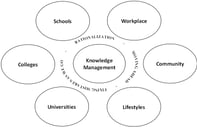Published on
Assessing Digital Badges

Let’s face it, learning doesn’t look like what it was traditionally imagined to be. Learning is not about seat time anymore; instead, learning is extending contexts, experiences and interactions. It’s not just about an individual jamming information into their brain; it is inclusive, social, participatory, flexible, creative and lifelong. A fraction of everything that I have learned – a very small fraction – came from the classroom, in a seat. Some of that is really important foundational knowledge (like fractions!) but it’s a tiny slice of my skill set and knowledge base. And yet, it’s the only learning that really counts. My grades and degrees are still the only record of my learning and often still are things I am asked to give to qualify my education.
That’s why I love the role that badges serve. The development of digital badges stems from this realization that the landscape for learning has changed drastically but the credentialing system hasn’t caught up with it. With badges, we are imagining an alternative, distributed system for credentialing where you can get recognition for learning of any and all kinds. That recognition is granular, so incremental learning is captured and the learner has a more comprehensive story to tell about her learning experiences.
To me, the core benefits and opportunities associated with badges are:
- Capturing the complete learning path
- Signaling achievements to key stakeholders such as potential employers
- Motivating engagement, retention and leveling up in learning
- Supporting innovation and flexibility in the skills we say matter.
- Building and formalizing identity and reputation in learning communities
In addition to all of these benefits, the there are a few things about the particular implementation that I think are big wins:
Badges as information, or “metadata specification”
In a learning ecosystem that embraces badges, each badge is not just an image or ‘sticker’ on the web, but rather is an actual set of metadata, or information, that tells you everything you need to know to understand that badge. This information is part of the badge so it travels with it wherever the badge goes. Information like issuer, issue date, criteria, evidence or artifact, endorsements, and expiration are available through digital badges. So these badges are not only giving us more information about a learner because they are capturing more incremental learning, but each one is jam-packed with information about the student’s assessment, evidence, et cetera. This concept of badges as information also gives us a lot of room for extensibility and further validation by simply adding more information to the badge.
Shared infrastructure
Mozilla, with the support of the MacArthur Foundation, has built the underlying ‘plumbing’ that allows badges to be an integral part of a learning ecosystem, rather than operating separately from grades in silos. This means any particular learner can earn badges across multiple different learning providers (badge ‘issuers’), pull them into one single collection in a central repository (their ‘Badge Backpack’) that they control, and then share the badges out with various audiences and stakeholders (badge ‘displayers’ or ‘consumers’). This common core infrastructure means that badges are interoperable and can work together for the learner. It also means we have an end-to-end value chain for badges – from the capturing and motivating on the learning experience end, to the collection and identity building in the Backpack, to the sharing and signaling on the display or consumption side.
Where I still think badges still need additional work are in the following areas:
Lack of naming standardization or taxonomies
The only aspect of badges that we have standardized is what information must be included with each badge. We’ve intentionally left the rest looser so that we don’t pre-optimize and squelch the innovation. But because of that, as badge adoption grows, how do we compare similar badges across organizations? Without naming standardization, how do we know that the Advanced Javascript badge from one organization is similar to JS NINJA badge from another?
We will never dictate one way or another but there are some changes we can make to the metadata specs — including simply adding additional fields for categorization — that could allow things to bubble up. We are already working on this within the Open Badges community.
Burden on the consumer
Badges are just information; each one carries plenty of supplemental information with it to help users understand the badge, but the burden is on the people to try to understand that badge, to compare it against others, and to sift through the information and make decisions. I actually think this will get much easier very quickly; I think a market will emerge around badge consumption and we will see lots of tools and filtering services to streamline this process.
Author Perspective: Analyst



